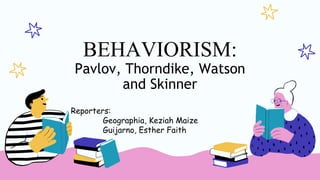
BEHAVIORISM.PPT in Facilitating Learner Centered Teaching.pptx
- 1. BEHAVIORISM: Pavlov, Thorndike, Watson and Skinner Reporters: Geographia, Keziah Maize Guijarno, Esther Faith
- 2. Objectives: 01 Explain the basic principles of behaviorism. 02 Make a simple plan applying the primary laws of learning. 03 Determine how to use rewards in the learning process more effectively.
- 3. The theory of behaviorism focuses on the study of observable and measurable behavior. It emphasize that behavior is mostly learned through conditioning and reinforcement.
- 4. BEHAVIORISM Pavlov & Watsons Thorndike Skinner Primary Laws Law of Effect Reinforcement Law of Exercise Law of Readiness Shaping of Behavior
- 7. Do the pictures remind you of someone?
- 8. IVAN PAVLOV - a Russian psychologist who is well known for his work in classical conditioning or stimulus substitution.
- 11. EXTINCTION In psychology, extinction refers to the gradual weakening of a conditioned response by breaking the association between the conditioned and the unconditioned stimuli.
- 12. SPONTANEOUS RECOVERY It refers to the return of a conditioned response (in a weaker form) after a period of time following extinction.
- 13. DISCRIMINATION In classical conditioning, discrimination is a process through which individuals learn to differentiate among similar stimuli and respond appropriately to each one.
- 14. HIGHER ORDER CONDITIONING It is when a conditioned stimulus is paired with a new neutral stimulus to create a second conditioned stimulus.
- 15. His connectionism theory gave us the original S-R framework of behavioral psychology. He explained that learning is a result of associations forming between stimuli (S) and responses (R). EDWARD LEE THORNDIKE
- 16. Law of Effect The law of effect states that behaviors followed by pleasant or rewarding consequences are more likely to be repeated, while behaviors followed by unpleasant or punishing consequences are less likely to be repeated.
- 17. Law of Exercise The law of exercise states that connections are strengthened through repetition and practice.
- 18. Law of Readiness The law of readiness states that learners must be physically and mentally prepared for learning to occur.
- 19. He was the first American psychologist to work with Pavlov's ideas. He too was initially involved in animal studies, then later became involved in human behavior research.. John B. Watson
- 20. He considered that humans are born with a few reflexes and the emotional reactions of love and rage. All other behavior is learned through stimulus-response associations through conditioning.
- 22. Classical Conditioning The Little Albert experiment presents an example of how classical conditioning can be used to condition an emotional response. Neutral Stimulus: A stimulus that does not initially elicit a response (the white rat).
- 23. Unconditioned Stimulus: A stimulus that elicits a reflexive response (the loud noise). Unconditioned Response: A natural reaction to a given stimulus (fear). Conditioned Stimulus: A stimulus that elicits a response after repeatedly being paired with an unconditioned stimulus (the white rat).
- 24. Conditioned Response: The response caused by the conditioned stimulus (fear).
- 25. Skinner’s work differs from that of the three behaviors before him in that he studied operant behavior. Thus, the theory came to be known as operant conditioning. Burrhus Frederick Skinner
- 26. Operant Conditioning is based upon the notion that learning is a result of change in overt behavior. Changes in behavior are the result of an individual's response to events (stimuli) that occur in the environment.
- 27. Reinforcement is the key element in Skinner's S-R theory. A reinforcer is anything that strengthens the desired response. There is a positive reinforcer and negative reinforcer.
- 28. A positive reinforcer is any stimulus that is given or added to increase the response.
- 29. A negative reinforcer is any stimulus that results in the increased frequency of a response when it is withdrawn or removed.
- 30. A negative reinforcer is different from a punishment because a punishment is a consequence intended to result in reduced responses.
- 31. Skinner also looked into extinction or non- reinforcement: responses that are not reinforced are not likely to be repeated.
- 33. Behavioral Chaining comes about when a series of steps are needed to be learned.
- 34. Reinforcement Schedules. Once the desired behavioral response is accomplished, reinforcement does not have to give 100% in fact, it can be maintained more successfully through what Skinner referred to as partial reinforcement schedules.
- 35. Fixed Interval Schedules. The target response is reinforced after a fixed amount of time has passed since the last reinforcement. Variable Interval Schedules. This is similar to fixed interval schedules but the amount of time that must pass between reinforcement varies.
- 36. Fixed ratio Schedules. A fixed number of correct responses must occur before reinforcement may recur. Variable Ratio Schedules. The number of correct repetitions of the correct responses for reinforcement varies.
- 37. REFERENCES :